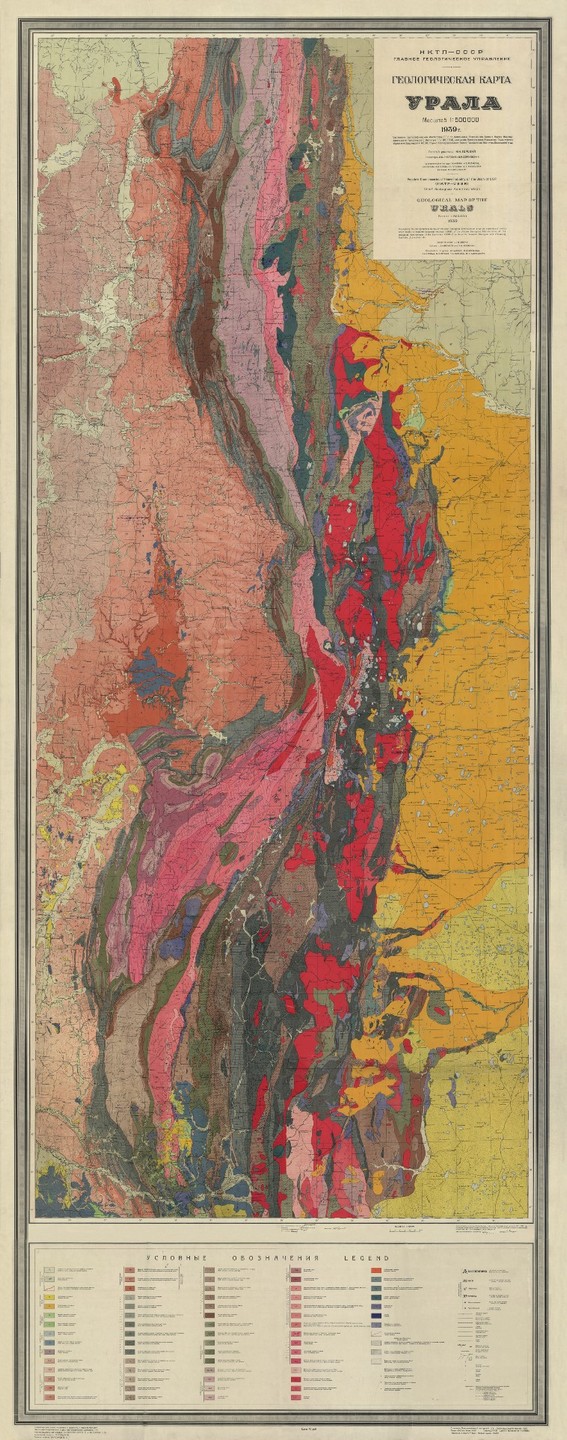1939 – TsNIGRI was renamed into the All-Union Scientific Research Geological Institute (VSEGEI). The Institute, freed from the administrative functions of managing the State Geological Survey of the country, remained the leading, and in many areas of research, the only scientific geological institution in the state. This imposed on VSEGEI a special responsibility for studying the country's geology and increasing its raw material base in order to provide the national economy with the necessary types of mineral resources.

The institute continued surveying and prospecting work begun in the 30s, posed new tasks. A systematic study of deposits and analysis of the geological structure of the regions led to the justification of the forecast for a number of minerals, to recalculations of their reserves, etc. The Higher School Affairs Committee included VSEGEI in the list of institutions entitled to accept doctoral and candidate’s dissertations.
VSEGEI directors in different years were: N.A. Bykhover (1939-1944), I.I. Gorsky (1944-1947), E.O. Pogrebitsky (1947-1949), L.Ya. Nesterov (1949-1956), N.I. Marochkin (1957-1963), E.T. Shatalov (1963-1969), A.D. Shcheglov (1969-1970), A.I. Zhamoyda (1970-1987), A.D. Shcheglov (1987-1998), since 1998, VSEGEI Вirector is O.V. Petrov.
1940 –The first Geological Map of the USSR at 1: 2,500,000 scale was published, compiled by TsNIGRI-VSEGEI employees, edited by D.V. Nalivkin.
Yu.Ir. Polovinkina and I.V. Danilevsky successfully defended doctoral dissertations at the Academic Council of the Institute. The following year, defense of doctoral dissertations by Yu.A. Bilibin, A.A. Logachev, M.P. Raspopov, S. P. Soloviev took place.
1941 – The first Geological map of the central and southern parts of Central Asia was compiled at 1: 750,000 scale, edited by A.P. Markovsky, as one of the results of the Tajik-Pamir expedition (1928-1941).

With the outbreak of World War II, the institute began a period of radical restructuring. Some of the employees who were able to carry weapons went to the defense of the homeland, the rest began to fulfill a civil duty on the labour front. L.I. Borovikov, V.S. Glazunov, A.E. Dovzhikov, V.S. Domarev, L.P. Kolosova, S.M. Korenevsky, L.I. Krasny, P.F. Li, F.Ya. Saprykin and many others treaded thorny front paths.
67 employees remained in besieged Leningrad; Yu.Ir. Polovinkina headed the local air defence target “VSEGEI” headquarters. All employees of the institute, library, and museum participated in defence work. A military geology department was created (G.P. Sinyagin, A.S. Semenov, I.A. Utkin, A.A. Logachev, B.Ya. Yufa, N.F. Pogrebov, I.K. Zaitsev, I.V. Danilevsky, S. A. Yakovlev and others) with specialized groups: engineering geology, hydraulic engineering, geophysical, Quaternary and others, who carried out orders of the Leningrad Front headquarters. At the request of the Maritime Hospital No. 1, located in the institute building, a technology for producing vitamins from needles was developed and a special installation was created. Matches were made.
1942– VSEGEI evacuation to the city of Kyshtym in the Urals was completed. The geologists of the institute, who left for field work and were evacuated to the rear, carried out responsible tasks to provide the military industry with the necessary raw materials, some of which were in the temporarily occupied territory. Non-ferrous metal deposits in Kazakhstan – K.I. Dvortsova, N.P. Mikhailov, A.I. Semenov; in the Rudny Altai – P.P. Burov, N.N. Kurek, V.P. Nekhoroshev, A.P. Nikolsky; iron ore in Kuznetsk Alatau and Mountain Shoria – A.L. Dodin; coal in Kirgizia – N.V. Shabarov; tin in Transbaikalia – S.S. Smirnov; boron in Primorye – S.P. Soloviev and many, many others were studied and explored.
High qualification of VSEGEI employees allowed them to lead and work in geological expeditions throughout the war, to take an active part in the creation of geological surveys and academies of sciences in the Union republics.

1944 – In February, VSEGEI activity in Leningrad was resumed. VSEGEI Director, Corresponding Member of the USSR Academy of Sciences I.I. Gorsky and the institute staff faced three equivalent and difficult tasks:
Determine the main directions of the institute research and begin the work itself;
Gather employees dispersed throughout the country and attract young staff;
Carry out repairs on its own, including a new ceiling in the building and restoration of laboratories.
Headquarters for the institute restoration was created, repair crews were organized from the institute’s staff, headed by V.V. Zatser, L.D. Kiparisova, T.I. Osyko, A.A. Ivanov and others. By the November holidays of 1944, glazing of the institute was completed, the staff began to clean up the rooms and laboratories. By the end of the year, these works were mostly completed. Heating was restored. The institute staff could proceed with the scientific work, which fully renewed in 1945.
M.I. Itsikson and A.P. Prokofiev, working in the Far East, discovered the Khingan tin ore deposit.
1945 – Prospective research in the field of regional geology and minerals was launched on a wide front. During the year, 12 laboratories and two workshops were restored. 17 parties left for the field. Under the guidance of I.I. Gorsky, work continued on compiling sheets of the State Geological Map of the USSR at 1: 1,000,000 scale, as well as on the preparation of the second edition of the Geological Map of the USSR at 1: 2,500,000 scale. The palaeontological laboratory organized by I.M. Pokrovsky soon became a leading scientific centre for palaeontological research in the country. Three doctoral (N.P. Luppov, V.F. Pchelintsev, N.M. Uspensky) and three candidate dissertations were defended at the Academic Council of VSEGEI.